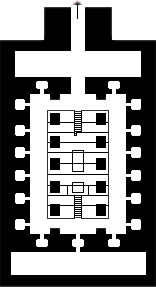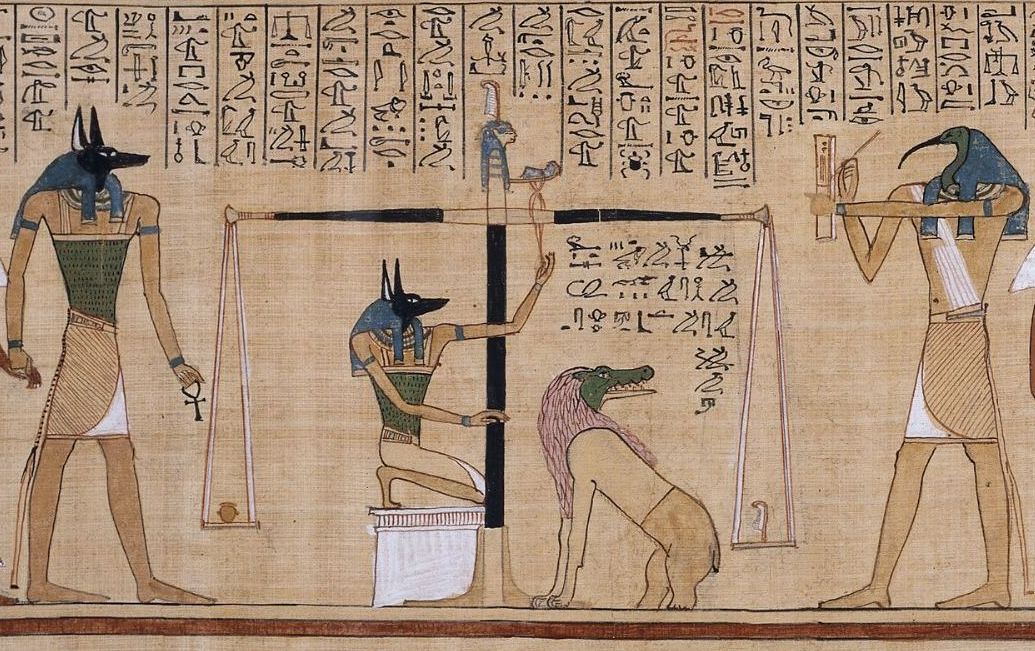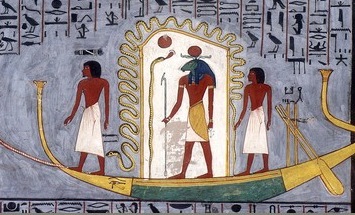|
Spell Of The Twelve Caves
The Spell of the Twelve Caves (also called the Wandering of the Soul; ar, تعويذة الكهوف الاثني عشر, Taewidhat al-Kuhuf al-Iathnay Eashar) is an ancient Egyptian funerary text from the New Kingdom. The earliest known copy is on a papyrus found in KV35 the tomb of Amenhotep II, and another copy was inscribed in the Osireion at Abydos under Merenptah. Although the text also appears in some copies of the Book of the Dead, where it is classified as Spell 168, the Egyptologist Alexandre Piankoff treated it as a distinct composition.Hornung (1999) pp. 54–55 The text describes the Duat, or underworld, as a realm divided into twelve caves, much like the twelve hours found in the Amduat and the Book of Gates The Book of Gates is an ancient Egyptian funerary text dating from the New Kingdom. It narrates the passage of a newly deceased soul into the next world, corresponding to the journey of the sun through the underworld during the hours of the nigh ..., two ot ... [...More Info...] [...Related Items...] OR: [Wikipedia] [Google] [Baidu] |
Funerary Text
Funerary texts or funerary literature feature in many belief systems. Its purpose is usually to provide guidance to the newly deceased or the soon-to-be-deceased about how to survive and prosper in the afterlife. Antiquity The most famous example of funerary literature is that of the ancient Egyptians, whose ''Book of the Dead'' was buried with the deceased to guide him or her through the various trials that would be encountered before being allowed into the afterlife. The ''Book of the Dead'' followed a tradition of Egyptian funerary literature that dated back as far as the 26th century BC. Similar practices were followed by followers of the cult of Orpheus, who lived in southern Italy and Crete in the 6th–1st century BC. Their dead were buried with gold plates or laminae on which were inscribed directions about the afterlife. In Mandaeism, the ''Left Ginza'' and parts of the ''Qolasta'' serve as funerary texts. Medieval Tibetan Buddhists still make use of the ''Bardo ... [...More Info...] [...Related Items...] OR: [Wikipedia] [Google] [Baidu] |
New Kingdom Of Egypt
The New Kingdom, also referred to as the Egyptian Empire, is the period in ancient Egyptian history between the sixteenth century BC and the eleventh century BC, covering the Eighteenth, Nineteenth, and Twentieth dynasties of Egypt. Radiocarbon dating places the beginning of the New Kingdom between 1570 BC and 1544 BC. The New Kingdom followed the Second Intermediate Period and was succeeded by the Third Intermediate Period. It was Egypt's most prosperous time and marked the peak of its power. The concept of a "New Kingdom" as one of three "golden ages" was coined in 1845 by German Egyptologist Baron von Bunsen, and its definition would evolve significantly throughout the nineteenth and twentieth centuries. The later part of this period, under the Nineteenth and Twentieth dynasties (1292–1069 BC), is also known as the ''Ramesside period''. It is named after the eleven pharaohs who took the name Ramesses, after Ramesses I, the founder of the Nineteenth Dynasty. Possib ... [...More Info...] [...Related Items...] OR: [Wikipedia] [Google] [Baidu] |
KV35
Tomb KV35 is the tomb of Pharaoh Amenhotep II located in the Valley of the Kings in Luxor, Egypt. Later, it was used as a cache for other royal mummies. It was discovered by Victor Loret in March 1898. Layout and history It has a dog's leg shape, typical of the layout of early Eighteenth Dynasty tombs, but several features make this tomb stand out. The burial chamber is rectangular and divided into upper and lower pillared sections, with the lower part holding the sarcophagus of the king. This style of burial chamber became standard for royal burials in the later New Kingdom. Later the tomb was used as a mummy cache. Mummies belonging to the following individuals were relocated here during the Third Intermediate Period and were identified by inscriptions on their burial wrappings: * Amenhotep II (the original tomb owner found in his original sarcophagus) Side Chamber: * Thutmose IV * Amenhotep III * Merneptah * Seti II * Siptah * Ramesses IV * Ramesses V * Ramesses VI * ... [...More Info...] [...Related Items...] OR: [Wikipedia] [Google] [Baidu] |
Amenhotep II
Amenhotep II (sometimes called ''Amenophis II'' and meaning ''Amun is Satisfied'') was the seventh pharaoh of the Eighteenth Dynasty of Egypt. Amenhotep inherited a vast kingdom from his father Thutmose III, and held it by means of a few military campaigns in Syria; however, he fought much less than his father, and his reign saw the effective cessation of hostilities between Egypt and Mitanni, the major kingdoms vying for power in Syria. His reign is usually dated from 1427 to 1401 BC. His consort was Tiaa, who was barred from any prestige until Amenhotep's son, Thutmose IV, came into power. Family and early life Amenhotep II was born to Thutmose III and a minor wife of the king: Merytre-Hatshepsut. He was not, however, the firstborn son of this pharaoh; his elder brother Amenemhat, the son of the great king's chief wife Satiah, was originally the intended heir to the throne since Amenemhat was designated the 'king's eldest son" and overseer of the cattle of Amun in ... [...More Info...] [...Related Items...] OR: [Wikipedia] [Google] [Baidu] |
Osireion
__NOTOC__ The Osirion or Osireion is an ancient megalithic structure located at Abydos, to the rear of the Mortuary Temple of Seti I. Its original purpose is unknown. It is an integral part of Seti I's funeral complex and is possibly built to resemble an 18th Dynasty Valley of the Kings tomb. The site contains a stone-paved island in the centre, chambers in both wings and, around the island, a water basin of yet undetermined but no less than 10.4m depth which was probably used as a well. Access was via a 69m stone lined passage. In the whole of Egypt, there is no architectural equivalent to the Osireion with its massive blocks, numerous trilithons, extraordinarily narrow and regular joints as well as a lack of round pillars except for the Valley Temple in Giza. The Osireion was discovered by archaeologists Flinders Petrie and Margaret Murray, who were excavating the site in 1902–03. The Osirion was originally built at a considerably lower level than the foundations of the ... [...More Info...] [...Related Items...] OR: [Wikipedia] [Google] [Baidu] |
Abydos, Egypt
Abydos ( ar, أبيدوس, Abīdūs or ; Sahidic cop, Ⲉⲃⲱⲧ ') is one of the oldest cities of ancient Egypt, and also of the eighth nome in Upper Egypt. It is located about west of the Nile at latitude 26° 10' N, near the modern Egyptian towns of El Araba El Madfuna and El Balyana. In the ancient Egyptian language, the city was called Abdju (''ꜣbḏw'' or ''AbDw''). The English name ''Abydos'' comes from the Greek , a name borrowed by Greek geographers from the unrelated city of Abydos on the Hellespont. Considered one of the most important archaeological sites in Egypt, the sacred city of Abydos was the site of many ancient temples, including Umm el-Qa'ab, a royal necropolis where early pharaohs were entombed. These tombs began to be seen as extremely significant burials and in later times it became desirable to be buried in the area, leading to the growth of the town's importance as a cult site. Today, Abydos is notable for the memorial temple of Seti ... [...More Info...] [...Related Items...] OR: [Wikipedia] [Google] [Baidu] |
Merenptah
Merneptah or Merenptah (reigned July or August 1213 BC – May 2, 1203 BC) was the fourth pharaoh of the Nineteenth Dynasty of Ancient Egypt. He ruled Egypt for almost ten years, from late July or early August 1213 BC until his death on May 2, 1203 BC, according to contemporary historical records.Jürgen von Beckerath, ''Chronologie des Pharaonischen Ägypten'', Mainz, (1997), pp.190 He was the thirteenth son of Ramesses II,Gae Callender, ''The Eye Of Horus: A History of Ancient Egypt'', Longman Cheshire (1993), p.263 only coming to power because all his older brothers had died, including his full brother Khaemwaset or Khaemwase. By the time he ascended to the throne, he was probably around seventy years old. He is perhaps best known for his victory stele, featuring the first known mention of the name Israel. His throne name was ''Ba-en-re Mery-netjeru'', which means "The Soul of Ra, Beloved of the Gods". Family Merneptah was likely the fourth child born to Isetnofret I and ... [...More Info...] [...Related Items...] OR: [Wikipedia] [Google] [Baidu] |
Book Of The Dead
The ''Book of the Dead'' ( egy, 𓂋𓏤𓈒𓈒𓈒𓏌𓏤𓉐𓂋𓏏𓂻𓅓𓉔𓂋𓅱𓇳𓏤, ''rw n(y)w prt m hrw(w)'') is an ancient Egyptian funerary text generally written on papyrus and used from the beginning of the New Kingdom (around 1550 BCE) to around 50 BCE. The original Egyptian name for the text, transliterated ''rw nw prt m hrw'', is translated as ''Book of Coming Forth by Day'' or ''Book of Emerging Forth into the Light''. "Book" is the closest term to describe the loose collection of texts consisting of a number of magic spells intended to assist a dead person's journey through the '' Duat'', or underworld, and into the afterlife and written by many priests over a period of about 1,000 years. Karl Richard Lepsius introduced for these texts the German name ''Todtenbuch'' (modern spelling ''Totenbuch''), translated to English as Book of the Dead. The ''Book of the Dead'', which was placed in the coffin or burial chamber of the deceased, was part of a tr ... [...More Info...] [...Related Items...] OR: [Wikipedia] [Google] [Baidu] |
Alexandre Piankoff , a Portuguese hypocoristic of the name "Alexandre"
{{Disambig ...
Alexandre may refer to: * Alexandre (given name) * Alexandre (surname) * Alexandre (film) See also * Alexander * Xano (other) Xano is the name of: * Xano, a Portuguese hypocoristic of the name " Alexandre (other)" * Idálio Alexandre Ferreira (born 1983), Portuguese footballer known as "Xano", currently playing for Sligo Rovers {{hndis ... [...More Info...] [...Related Items...] OR: [Wikipedia] [Google] [Baidu] |
Duat
The Duat ( egy, dwꜣt, Egyptological pronunciation "do-aht", cop, ⲧⲏ, also appearing as ''Tuat'', ''Tuaut'' or ''Akert'', ''Amenthes'', ''Amenti'', or ''Neter-khertet'') is the realm of the dead in ancient Egyptian mythology. It has been represented in hieroglyphs as a star-in-circle: 𓇽. The god Osiris was believed to be the lord of the underworld. He was the first mummy as depicted in the Osiris myth and he personified rebirth and life after death. The underworld was also the residence of various other gods along with Osiris. The geography of the ''Duat'' is similar in outline to the world the Egyptians knew: There are realistic features like rivers, islands, fields, lakes, mounds and caverns, but there were also fantastic lakes of fire, walls of iron, and trees of turquoise. In the ''Book of Two Ways'' (a Coffin Text) there is even a map-like image of the ''Duat''. Resident souls, gods, and demons The ''Duat'' was also a residence for various gods, including Osi ... [...More Info...] [...Related Items...] OR: [Wikipedia] [Google] [Baidu] |
Amduat
The Amduat ( egy, jmj dwꜣt, literally "That Which Is In the Afterworld", also translated as "Text of the Hidden Chamber Which is in the Underworld" and "Book of What is in the Underworld"; ar, كتاب الآخرة, Kitab al-Akhira) is an important ancient Egyptian funerary text of the New Kingdom of Egypt. Like many funerary texts, it was found written on the inside of the pharaoh's tomb for reference. Unlike other funerary texts, however, it was reserved only for pharaohs (until the Twenty-first Dynasty almost exclusively) or very favored nobility.Hornung (1999), p.27 It tells the story of Ra, the Egyptian sun god who travels through the underworld, from the time when the sun sets in the west and rises again in the east. It is said that the dead Pharaoh is taking this same journey, ultimately to become one with Ra and live forever. The underworld is divided into twelve hours of the night, each representing different allies and enemies for the Pharaoh/sun god to encounter ... [...More Info...] [...Related Items...] OR: [Wikipedia] [Google] [Baidu] |


.jpg)



